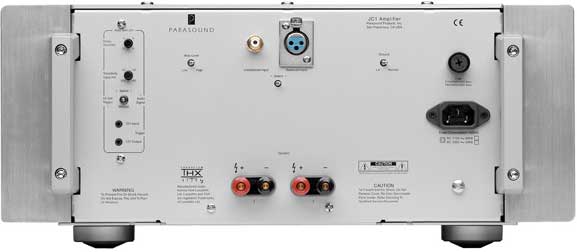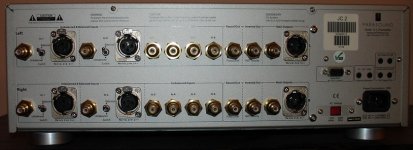SY, regarding the input connector you are complaining about. First, what model did your boss buy? What is the ID on the connector? This is important, because I specify NEUTRIK for the JC-1, JC-2, and JC-3.
However, cheaper products, even based on my schematics often use cheap look-alikes, and we have stirred up big trouble internally over it, in this past, when they tried to use the cheap, steel based connectors on the initial JC-1.
However, IF the model is the HCA-23, I will have to allow the cheaper connector to be used. If it is the HCA-21, I will contact Parasound and complain.
In any case, the 'sonic' aspects of this connector could not possibly be something that you would believe in or be concerned about.
However, cheaper products, even based on my schematics often use cheap look-alikes, and we have stirred up big trouble internally over it, in this past, when they tried to use the cheap, steel based connectors on the initial JC-1.
However, IF the model is the HCA-23, I will have to allow the cheaper connector to be used. If it is the HCA-21, I will contact Parasound and complain.
In any case, the 'sonic' aspects of this connector could not possibly be something that you would believe in or be concerned about.
Too bad but even JC-1 has cheap chinese XLRs!! No Neutrik.

http://www.parasound.com/img/halo/jc1_rear_big.jpg

http://www.parasound.com/img/halo/jc1_rear_big.jpg
PMA is this your personal unit, or a picture from earlier years?
It is a picture from official Parasound website, as you may read from the web address.
Vladimir, yours are OK. But not gold plated, I would guess.
This exactly why, if you care about humanity, you should do a clear and concise tell all. True, it is basically all scattered here on these threads some how, some way, but getting it all togeather from here is almost impossible.I am close to 71 years old, my associates are dying around me, two passed away just this last month. I just passed though a personal cancer scare, myself. I feel that I have limited time to give free advice
Even little me, at 51 years young, have started to document what I know that may be of value.
Ya' guys want a laugh? Here is my audiophile life is weirder than fiction story.
Vladimir, yours are OK. But not gold plated, I would guess.
You are right, but RCAs seem to be gold plated.
To my regret, any separate preamp does not fit my demands, anymore. I was happy with JC2 only short time, after that I have come to an integrated amp + external power supply approach, and stay with it for 5 last years.
Are Neutrik less expensive than Canon XLRs ? I found Canon silver very good on the long run. When oxided, several successive plug/unplug and contacts are perfect again. I have some VERY old, working perfect.
The old problem with manufacturers or boss attempts to save few bucks, destroying the whole thing will remain for ever. I remember our boss, in 70's trying to change our epoxy boards to cardboards ones ! We had to argue with mechanical issues for the preamp, and temperature issue for our amp to keep them the way they had to be, and threaten him of our resignations !
The old problem with manufacturers or boss attempts to save few bucks, destroying the whole thing will remain for ever. I remember our boss, in 70's trying to change our epoxy boards to cardboards ones ! We had to argue with mechanical issues for the preamp, and temperature issue for our amp to keep them the way they had to be, and threaten him of our resignations !
Last edited:
Test or bait?
Maybe you prefer these:
http://www.ti.com/lit/an/snoa475c/snoa475c.pdf
http://www.intersil.com/content/dam/Intersil/documents/an55/an551.pdf
Intersil fig. 1 standard Teradyne/GR/Tek/etc. test loop ancient history.
So, it is just a LOOK' decision, because of the existence of fakes, it looks cheaper ?Too many fakes of Cannons now. At 50 cents/pc.
Manufacturers order their parts to the manufacturers, so they are not in concern with fakes. I found the Canon flexible isolator better, for heavy professional use, while Neutrik cords plugs are easier to weld and more resistant to lateral pulls.
So what your saying is...power cords make a difference even in a stadium.
jn
Then there was the first time I used amplifiers with switching power supplies. I changed all the IEC cords to shielded ones. With 100+ amplifiers it made a difference. They were 14 gauge. Which under code would work for amplifiers rated to 3000 watts. Of course none of the amplifiers were that large or even loaded to below 8 ohms.
The next consultant in had all the power cords changed to thicker ones. Of course. They ended up with imported thicker cords still 14 gauge just way more plastic.
Christophe, after new listening tests of the buffered AD797 I find this opamp very, or I would say extremely transparent, with great resolution of highs and details, and tight solid bass.
What would be a good reason for any op amp DC coupled gain stage to NOT have a "tight bass", or is this poetry?
Wile they can waste a lot of money, in the same time, with stupid things like motorized lateral rear mirrors in your car, driver side, witch add nothing and cost a lot each time you have to replace one !I am afraid that audio manufacturers are trying to decrease input costs as much as possible..
So you were hearing changes according to the polarity of only the mid driver then ?....if so, then there is nothing to be embarrassed about. Not noting the missing highs is another matter.
Dan.
Dan, no. The polarity of the mid was fixed. I was only changing the tweeter’s polarity.
The important point in this story is that because I was physically doing the action of switching the polarity (thus I was “certain” that an acoustical different effect will take place) I was genuinely fooled by my senses/brain that I was perceiving acoustic differences.
I had unwillingly turned this test into a blind test, on which of course I failed.
My hearing acuity (very degraded) is irrelevant. Were it relevant, I should have decided that I did not hear any difference.
Ed wrote on a relevant case with a professional involved. http://www.diyaudio.com/forums/analog-line-level/146693-john-curls-blowtorch-preamplifier-part-ii-3354.html#post3341643
This sent me back some 30 years ago when a singer was testing different mikes in a venue for to choose the best one for her.
It was me that brought the mikes there and I was asked to adjust the controls.
“Give me highs”, “give me lows”, “give me presence” she was not satisfied with the results, all this for half an hour.
After a while, on each call from her, I was just pretending that I was moving the controls with a high precision, so she could see that. I was doing no actual adjustment. She started to like the results.
She ended with one mike and asked me to mark the final settings on the console.
She was fooled by her senses as I was -confirmed- fooled 30 years later (and unconfirmed all these years and beyond).
Enough A/B comparisons and even very fine effects are reliably discernable.
See the storie of the three fools above.
You have –for your own sake- to prove this reliability to you.
Typical clean sand has no permanently magnetisable iron content, however sandbags can be a good mechanical damping method.
That’s why I proposed it, suggesting to look for mechanical issues, before loosing your time with investigations on magnetics. Compare the results of the sandbag with the results of the brick.
In the observational cases I have described, I am sincerely asking for physics explanations from the theory adept fellows collected here....oh well....
Dan.
It follows from your hypothesis that you have to check first if the brick has any relative permeability different from the value of 1. Are you willing to do that?
George
Last edited:
Limited slew-rate, witch gives the basses attacks to sound 'soft'. A kick drum can have a very fast attack edge, at high level, and we perceive-it as 'bass'.What would be a good reason for any op amp DC coupled gain stage to NOT have a "tight bass", or is this poetry?
Limited slew-rate, witch gives the basses attacks to sound 'soft'. A kick drum can have a very fast attack edge, at high level, and we perceive-it as 'bass'.
 When I started dropping in high slew rate op-amps to modify a preamp or reverb the bass was the first thing I noticed.
When I started dropping in high slew rate op-amps to modify a preamp or reverb the bass was the first thing I noticed.- Status
- Not open for further replies.
- Home
- Member Areas
- The Lounge
- John Curl's Blowtorch preamplifier part II

